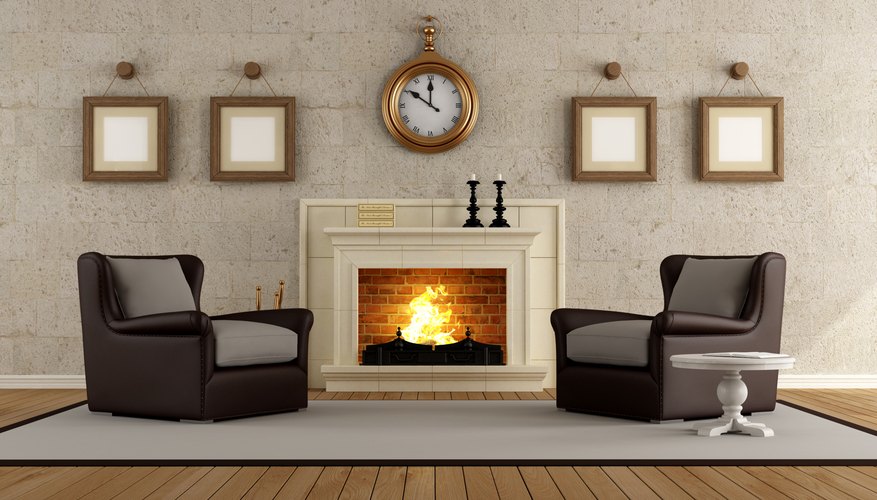Every fireplace needs a good, strong, and aesthetically pleasing hearth. The hearth acts not only as the attractive foundation for the fireplace, it is also the heat barrier that keeps the floor from getting too hot while the fire is burning. Using strong, non-combustible materials when constructing a fireplace hearth ensures the continued safety of your family, and that the hearth installation will last for years and years to come. Finishing the hearth with an attractive natural stone or porcelain tile gives the hearth the customised aesthetic appeal that will draw everyone's attention to this focal point of the room.
Remove the existing flooring where the hearth will be installed, if flooring (besides the plywood subflooring) is present. If the existing flooring is carpet and you plan to keep the carpet after the hearth and fireplace are installed, pull the carpet up and roll it back onto itself. Remove the carpet pad in the same manner. Do not cut the carpet for any reason.
- Every fireplace needs a good, strong, and aesthetically pleasing hearth.
- Remove the existing flooring where the hearth will be installed, if flooring (besides the plywood subflooring) is present.
Sweep any debris off of the subfloor and run a vacuum over the subfloor where the hearth will be installed. This ensures that no dirt or gravel will be present to create an unlevel surface.
Cut two layers of 1.2 cm (1/2 inch) cement backer board to size. Hardibacker, Wonderboard and Durock backer board brands do well. Mix a bag of unmodified thinset to the consistency of peanut butter and spread the thinset over the surface of the subfloor with a 6 mm by 9 mm by 6 mm (1/4 by 3/8 by 1/4) tiling trowel. Lay the first layer of backer board into the wet thinset and fasten the backer board to the subfloor with the appropriate brand of 3.1 cm (1 1/4 inch) backer board screws. Lay the second layer of backer board directly on top of the first and fasten the second layer with 4 cm (1 5/8 inch) backer board screws. Allow the thinset to dry for at least twenty four hours before continuing.
- Sweep any debris off of the subfloor and run a vacuum over the subfloor where the hearth will be installed.
- Lay the first layer of backer board into the wet thinset and fasten the backer board to the subfloor with the appropriate brand of 3.1 cm (1 1/4 inch) backer board screws.
Apply the tile of your choice to the backer board to finish off the exposed surface and to make it an attractive space. Use tile spacers in between the tiles to be sure the grout lines remain straight and uniform. Natural stone tiles are very appropriate to use when installing a fireplace hearth. Porcelain tiles are also an appropriate option. Use a modified thinset mortar when installing the tile. Do not use an acrylic mastic to set tile around a fireplace. Allow the thinset to dry for twenty four hours.
- Apply the tile of your choice to the backer board to finish off the exposed surface and to make it an attractive space.
- Use tile spacers in between the tiles to be sure the grout lines remain straight and uniform.
Install the grout between the grout joints with a rubber grout float. The grout joints are the spaces in between the tiles and a rubber grout float is a rubber trowel used to install grout in between the tiles. Mix the grout to the consistency of peanut butter and force the grout into each grout joint so no cavities will be left behind. Otherwise, these cavities may cave in later on and will have to be filled with the exact same grout colour.
- Install the grout between the grout joints with a rubber grout float.
- Mix the grout to the consistency of peanut butter and force the grout into each grout joint so no cavities will be left behind.
Measure the finished height of the hearth with a tape measure. Frame the edge of the hearth with a finished hardwood that matches the woodwork in the rest of the home. Fasten the hardwood to the subfloor with long finish nails (the nail length will vary depending on the finished thickness of the wood).
Roll the carpet back over the hearth and use the hearth trim work as a cutting guide to trim the carpet pad and the carpet to size around the hearth with a utility knife. Install carpet tack strips around the trim work by using a hammer and the nails that are included with the tack strips to hold the tack strips in place. Then reglue the pad to the subfloor and stretch the carpet into place around the hearth. If the carpet is cut accurately, the carpet may not ned to be restretched.
